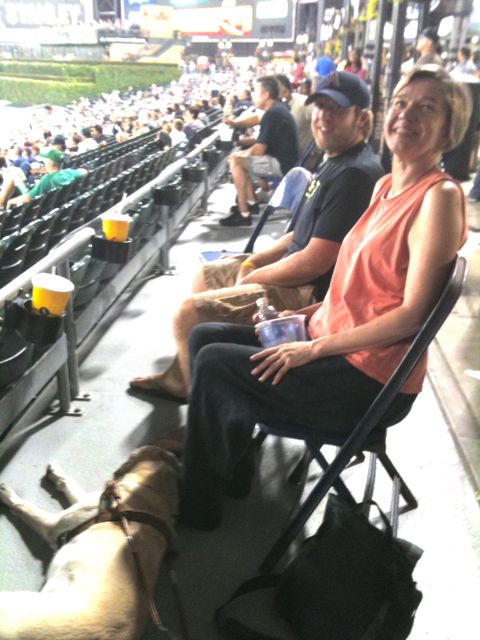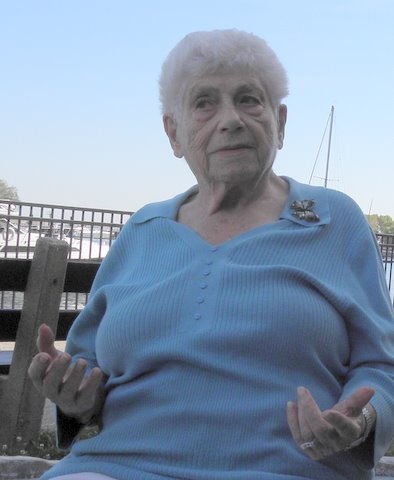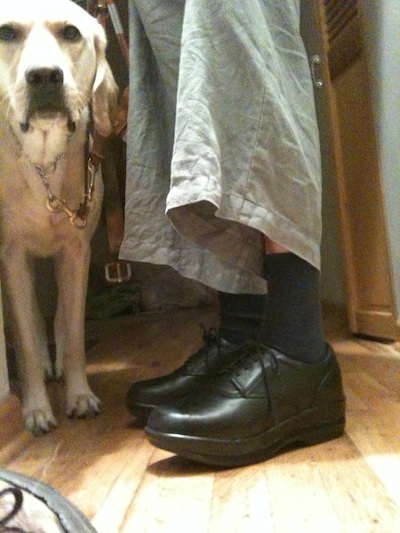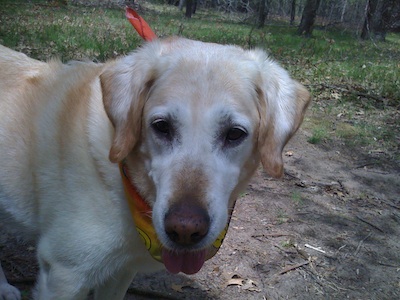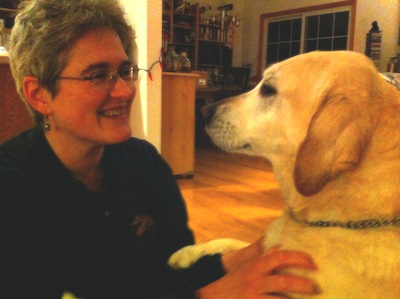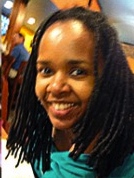Afraid of the blindfold
August 24, 2011 • 14 Comments • Posted in baseball, blindness, Flo, guide dogs, Seeing Eye dogs, UncategorizedA trainer from the Seeing Eye was in the Chicago area visiting other graduates last week. Eric had heard I broke my foot. Did I want him to stop by and see how things were going with Harper?
I cradled the phone receiver between my ear and shoulder and leaned down to tighten the laces on my orthopedic shoes. “I’m still not supposed to walk much,” I sighed. “Seems like it’d be a waste of time for you to come all the way downtown just to watch us walk around the block.” Eric assured me I wouldn’t be wasting his time. He arrived before lunch, admired my shoes, and followed as Harper led me out the door.
Harper did not disappoint. Well, I mean, he did disappoint, but as long as Eric was here to help with potential problems, we gave him a good show. Harper cowered on the sidewalk for no apparent reason, slowed down to a dreadful pace as we neared an intersection, and refused to turn right at a corner where we usually went left. The good news? Eric didn’t notice Harper trembling or shaking when he cowered. “He doesn’t seem afraid,” Eric said. “He just wants to do the right thing, and when he isn’t sure what the right thing is, he balks.”
Eric suggested I try to boost Harper’s confidence. Cheer him on, tickle his back side when we’re traveling at a good pace, tell him over and over what a great job he’s doing. “He’s a sensitive guy, and he needs to know he’s doing right.” Eric’s last bit of advice brought me right back to my teenage years with Flo: “stand up straight!” I need to pull my shoulders back, refrain from leaning over Harper when I give commands. If I speak with authority when I give a command, my own confidence should rub off on Harper.
Harper also loves to retrace his steps. “He’s almost shepherdy!” Eric marveled. It’s true that Harper’s homing instinct can be a bit extreme, but it came in handy when I asked Eric if he was hungry for lunch. Harper knew exactly how to get to Hackney’s.
Over a salad and a grilled cheddar, avocado & tomato sandwich I asked Eric how he ended up being a Seeing Eye dog trainer. “I was a puppy raiser!” he said with pride. “Born and raised in New Jersey, and never left.” Eric’s family lives close to Morristown (where The Seeing Eye is located), and he raised his first puppy, a Lab named Yorick, when he was ten. “My sister still volunteers for the Seeing Eye, she’s raising a puppy now.” Eric has so much energy that I assumed he was in his early twenties and must have applied to be a Seeing Eye trainer right out of college. “Oh, no!” he said. I could tell from his voice that he was smiling. “You’re gonna laugh when I tell you what stopped me: I was afraid to go under the blindfold.”
I didn’t laugh. I understood. It’s scary, not being able to see.
A story in the NJ Monthly explains why the blindfolds are necessary in training:
For the first two months, the trainers walk the dogs and help them learn where to stop and how to lead owners around obstacles on the ground and overhead. The dogs receive no treats or punishment; they are rewarded with praise or, when necessary, disciplined verbally or through the absence of praise—or occasionally corrected with a tug on the leash that does not hurt the dog. Throughout the process, the trainers rate the progress and characteristics of each dog on a computer system, and at certain times the dog is tested with a blindfolded trainer. “At the midterm [blindfold test], a supervisor will be standing close and giving some help,” says apprentice instructor Kaelin Coughlin, 24. “The final blindfold is a test to be sure the dog is safe and ready, and the supervisor stands further behind.”
Stacey the bartender took our plates while Harper remained still at our feet. As she refilled our diet Coke and iced tea, I asked Eric what he studied in college. He said he got a degree in history, and after a so-called “normal” job he finally mustered up his courage and applied at The Seeing Eye. He’s been training dogs for three years now.
We talked about other things: Eric’s life on a small farm in New Jersey, his wife’s love of horses, and his love for baseball. The White Sox were in town, Eric didn’t have anything scheduled for the next evening, so we agreed to meet for a game. “I can see how Harper handles a crowd!” Eric said with a laugh, acknowledging how much he loves his job. “But I’m not gonna lie to ya’ — I’m still scared to death of the blindfold!”
